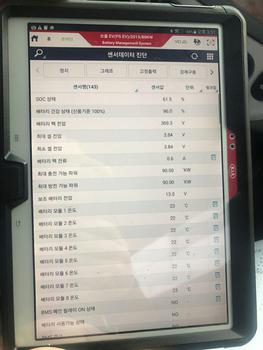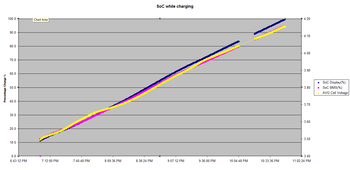2016Electric said:
I'm a little concerned about my stats. ..
Yes, that recent reading is bad. But, this data is often extremely varied. We need an average of multiple readings over a few seasons to make a more reliable judgement.
Something else you could try is a
calibration check. Here's one I did a year ago. ---
Old post from Tue Apr 05, 2016 4:17 am
JejuSoul said:
... To calibrate your battery pack you need to charge to 100% then drive the pack down to nearly empty and then charge to 100% again. It is on this 2nd 100% charge that calibration occurs.
Results for my calibration test:- charged to 100%, drove 200km, charged to 100%
I stopped driving and started charging at 9% SOC.
GOM before 174km, GOM after 178km. My highest so far this Spring.
Deterioration values did reset. min det reduced from 6.8% to 5.5% at just above 4.08V (some cells were showing 4.10V) It was at 92% SOC, Battery pack =393V
max det reduced from 9.0% to 8.5% at 100% after I turned the car off to unplug the c harger.
I have seen much greater movement in these numbers recently that was not associated with charging to 100%.
Energy charged = 25.0 kWh for 91% (based on the BMS data) => Full pack 25/0.91 = 27.47kWh
Energy discharged = 23.9 kWh for 91% (based on the BMS data) => Full pack 23.9/0.91 = 26.3kWh
The energy charged figure is simple; it is the difference in cumulative energy charged before and after charging.
The energy discharged is the difference in cumulative energy discharged during driving minus the regenerative energy put back into the battery.
I replicated this calibration check over the last 5 days. It is just my normal driving, no special trips or hypermiling involved.
Results for my calibration test:- charged to 100%, drove 210km, charged to 100%
I stopped driving and started charging at 9% SOC.
GOM before 182km, GOM after 187km.
At 92% SOC deterioration values did not reset, but the cell numbers for the min and max did. (from 83, 29 to 1, 2)
max det reduced from 11.5% to 10.5% at 100%.
min det increased from 7.1% to 7.4% at 100%.
Energy charged = 24.5 kWh for 91% (based on the BMS data) => Full pack 24.5/0.91 = 26.92kWh
Energy discharged = 23.6 kWh for 91% (based on the BMS data) => Full pack 23.6/0.91 = 25.9kWh
Regenerated Energy on the trip was 14.5kWh.
C harger efficiency was 24.5 / 26.48 = 92.5%
From this data, even though my car is two years old it still has the same usable capacity.



















![300W Car Power Inverter 12V to 110V,PiSFAU DC to AC Car Plug in Adapter Outlet with Multi USB[24W USB-C] /USB-Fast Charger(24W) Car Inverter,Car Charger for Laptop Vehicles Road Trip Essentials](https://m.media-amazon.com/images/I/41-KedJShYL._SL500_.jpg)









































